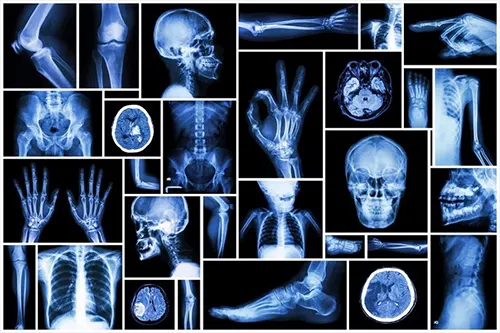http://rxreviewz.com/) 92%;”>
Diagnostic X-Ray
An X-ray creates images of the inside components of your body, most notably your bones.
X-ray beams flow through your body, and depending on the density of the material they pass through, they are absorbed in different amounts. On X-rays, bones and metal appear white, air (like in your lungs) will appear black, and soft tissue (fat, muscle) will show up in gray.
invented x-rays. In 1901, Röntgen earned a Nobel Prize in Physics.
Trusted Source
Academic textbook
Backed by various research articles
Written for professionals
Since then, x-rays have saved many lives and are invaluable tools used to detect abnormalities and make early diagnosis of disease or injury.
How Do X-rays Work?
Trusted Source
Academic textbook
Backed by various research articles
Written for professionals

Diagnostic X-rays
X-rays are commonly used to assess:
X-ray is not a great option for torn ligaments in your knee or a torn rotator cuff in your shoulder. MRI is more suitable for soft tissue problems like a torn ligament in the ankle. When assessing for herniated discs, MRI is also chosen because it allows the doctor to examine the bones in your spine, the spinal cord and the discs.
X-ray imaging, uses ionizing radiation which contains enough energy to potentially cause DNA damage.
Radiation exposure. Can cause a small increase in the possibility of developing cancer later in life.
According to the US Food and Drug Administration (FDA), the risk of cancer from X-ray radiation is dependent on:
Rarely, x-rays can cause:
X-ray imaging isn’t for everyone. Your doctor might caution against x-rays if you:
Food and medications
Clothing and personal items
Before the procedure, tell your doctor if you:
There is no pain involved during x-rays.
The physician will position the patient against a panel that holds x-ray film. The patient is instructed to hold still for a few seconds while the x-ray is taken so that the image does not come out blurry.
2-5 x-rays are taken at different angles of each area being x-rayed.
Once all of the x-rays are taken, the physician may ask you to wait a minute until all the images are developed.
Depending on the number of areas being x-rayed, the exam can take 5-20 minutes.
You will be able to return to normal activities immediately after x-rays. There are not usually any side effects with x-rays but your physician may schedule a time to go over the results.
X-rays need to be interpreted. The doctor spends additional time combing through each aspect of the x-rays looking for a variety of pathologies and assessing your current condition. A report is typically written into your notes by the doctor or is sent to a specialist for advanced reading. Since our x-rays are digital, they are easily accessible and can also be sent to other offices upon request.
Can I get an x-ray without insurance?
- We take a variety of payment methods including cash, credit and debit cards.
Can I get an x-ray without referral or order?
- You do not need an order to get an x-ray with us.
In order to back up the information in our articles, Arizona Chiropractic & Holistic Health Center exclusively cites high-quality sources such as peer-reviewed research. We strive to provide accurate, dependable, and trustworthy content based on the best evidence avaliable.
- (2020, January 5). Wilhelm Röntgen (1845–1923) – Ontdekker röntgenstraling. https://historiek.net/wilhelm-rontgen-ontdekker-rontgenstraling/550/
- Novelize, Robert. Squire’s Fundamentals of Radiology. Harvard University Press. 2018. ISBN 978-0674057951 1
- Tafti D, Maani CV. X-ray Production. [Updated 2021 Aug 3]. In: StatPearls [Internet]. Treasure Island (FL): StatPearls Publishing; 2021 Jan-. Available from: https://www.ncbi.nlm.nih.gov/books/NBK537046/
- National Institute of Biomedical Imaging and Bioengineering (NIBIB). (n.d.). X-rays. Retrieved September 23, 2021, from https://www.nibib.nih.gov/science-education/science-topics/x-rays
- Godfrey M. F. (1948). X-RAY DIAGNOSIS AND THERAPY IN ARTHRITIS. California medicine, 69(1), 16–18. https://pubmed.ncbi.nlm.nih.gov/18731484/
- Calthrop, L. C. E. (1932). CHRONIC RHEUMATISM. BMJ, 2(3730), 32. https://doi.org/10.1136/bmj.2.3730.32
- The Editors of Encyclopaedia Britannica. (2018, July 4). diagnostic imaging | Definition & Types. Encyclopedia Britannica. https://www.britannica.com/science/diagnostic-imaging
- Center for Devices and Radiological Health. (2020, September 28). Medical X-ray Imaging. S. Food and Drug Administration. https://www.fda.gov/radiation-emitting-products/medical-imaging/medical-x-ray-imaging
- Center for Devices and Radiological Health. (2017, December 9). X-Rays, Pregnancy and You. S. Food and Drug Administration. https://www.fda.gov/radiation-emitting-products/medical-x-ray-imaging/x-rays-pregnancy-and-you

